Tesco Operations Management Case Study
VerifiedAdded on 2020/12/18
|19
|4612
|119
AI Summary
Contribute Materials
Your contribution can guide someone’s learning journey. Share your
documents today.
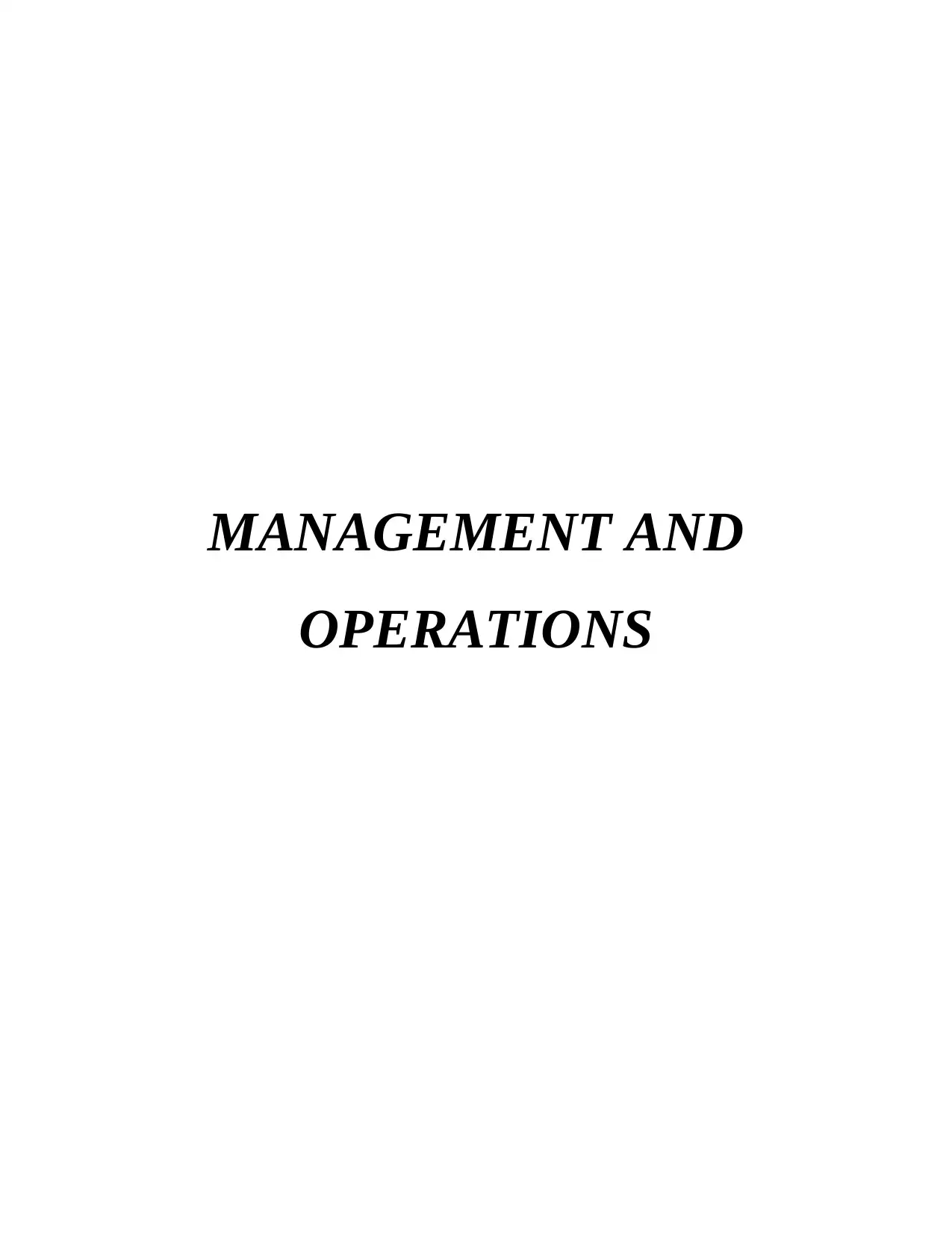
MANAGEMENT AND
OPERATIONS
OPERATIONS
Secure Best Marks with AI Grader
Need help grading? Try our AI Grader for instant feedback on your assignments.
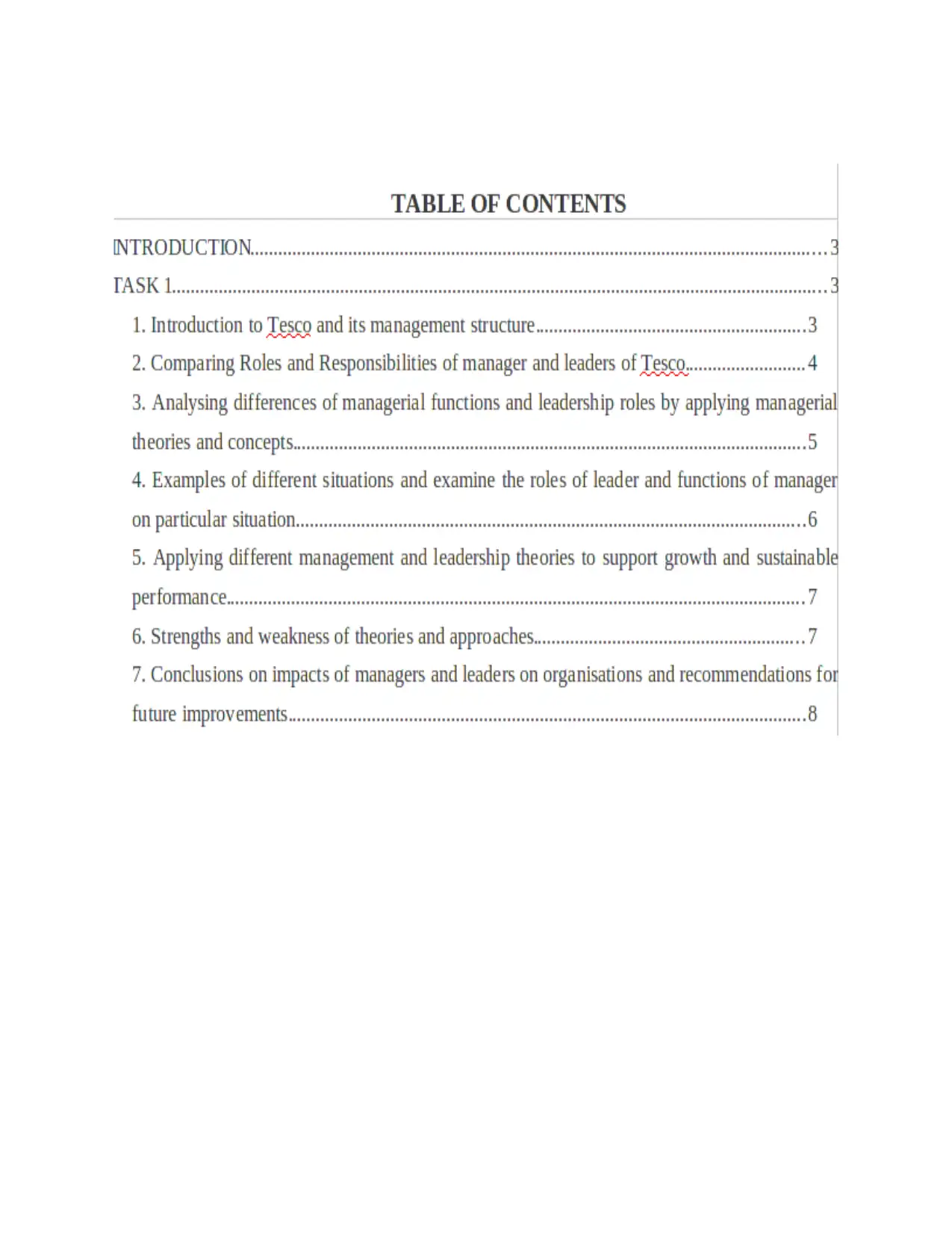
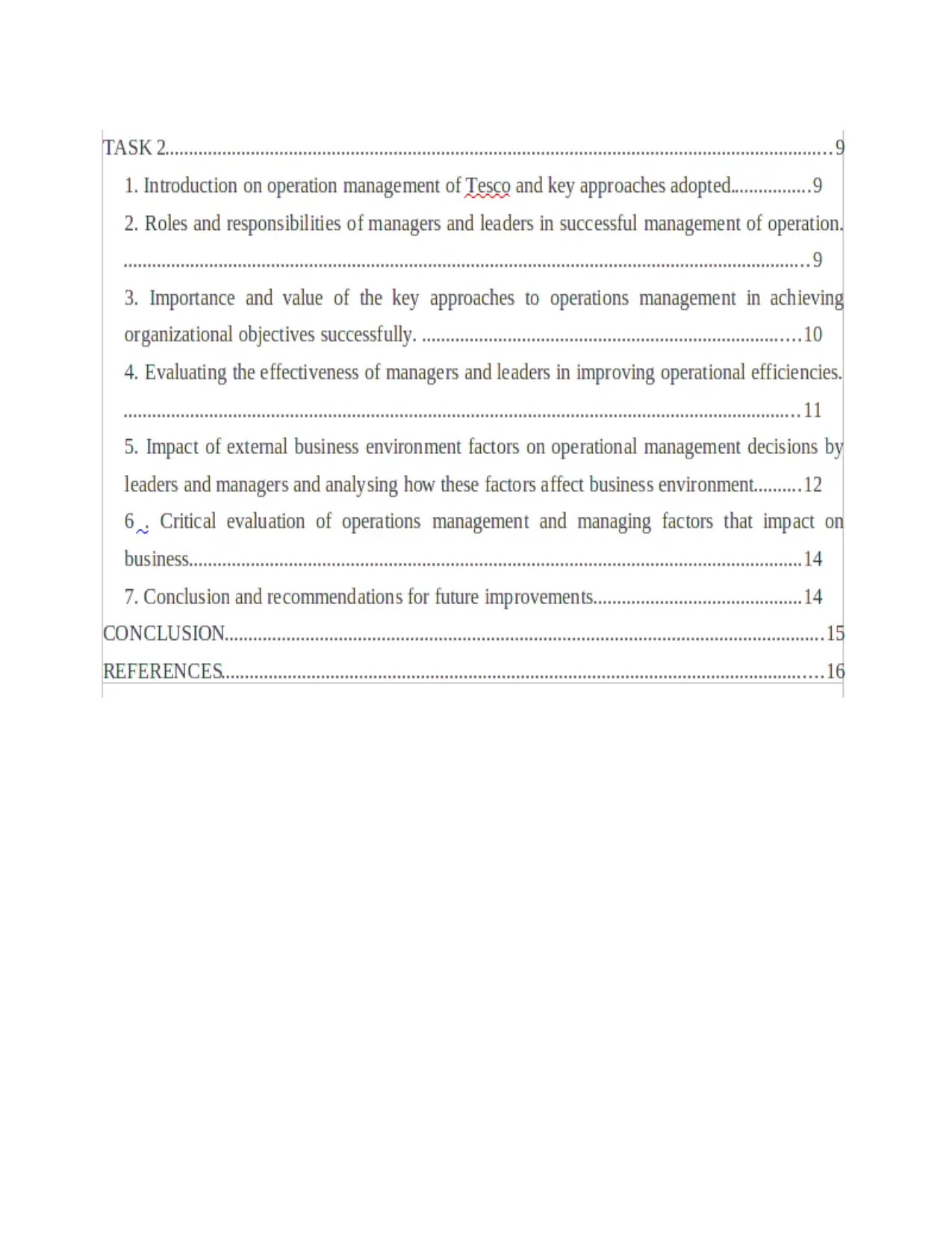
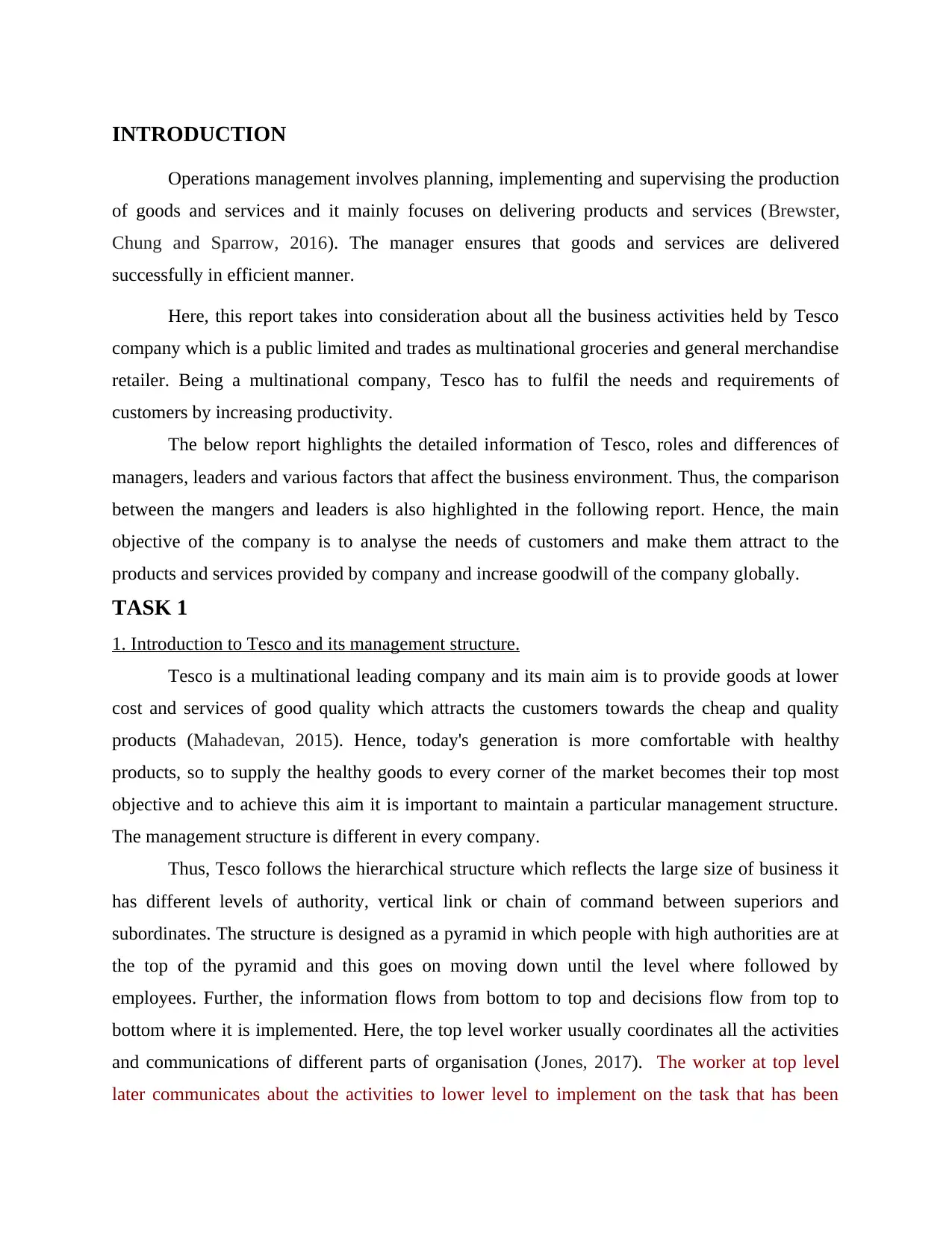
INTRODUCTION
Operations management involves planning, implementing and supervising the production
of goods and services and it mainly focuses on delivering products and services (Brewster,
Chung and Sparrow, 2016). The manager ensures that goods and services are delivered
successfully in efficient manner.
Here, this report takes into consideration about all the business activities held by Tesco
company which is a public limited and trades as multinational groceries and general merchandise
retailer. Being a multinational company, Tesco has to fulfil the needs and requirements of
customers by increasing productivity.
The below report highlights the detailed information of Tesco, roles and differences of
managers, leaders and various factors that affect the business environment. Thus, the comparison
between the mangers and leaders is also highlighted in the following report. Hence, the main
objective of the company is to analyse the needs of customers and make them attract to the
products and services provided by company and increase goodwill of the company globally.
TASK 1
1. Introduction to Tesco and its management structure.
Tesco is a multinational leading company and its main aim is to provide goods at lower
cost and services of good quality which attracts the customers towards the cheap and quality
products (Mahadevan, 2015). Hence, today's generation is more comfortable with healthy
products, so to supply the healthy goods to every corner of the market becomes their top most
objective and to achieve this aim it is important to maintain a particular management structure.
The management structure is different in every company.
Thus, Tesco follows the hierarchical structure which reflects the large size of business it
has different levels of authority, vertical link or chain of command between superiors and
subordinates. The structure is designed as a pyramid in which people with high authorities are at
the top of the pyramid and this goes on moving down until the level where followed by
employees. Further, the information flows from bottom to top and decisions flow from top to
bottom where it is implemented. Here, the top level worker usually coordinates all the activities
and communications of different parts of organisation (Jones, 2017). The worker at top level
later communicates about the activities to lower level to implement on the task that has been
Operations management involves planning, implementing and supervising the production
of goods and services and it mainly focuses on delivering products and services (Brewster,
Chung and Sparrow, 2016). The manager ensures that goods and services are delivered
successfully in efficient manner.
Here, this report takes into consideration about all the business activities held by Tesco
company which is a public limited and trades as multinational groceries and general merchandise
retailer. Being a multinational company, Tesco has to fulfil the needs and requirements of
customers by increasing productivity.
The below report highlights the detailed information of Tesco, roles and differences of
managers, leaders and various factors that affect the business environment. Thus, the comparison
between the mangers and leaders is also highlighted in the following report. Hence, the main
objective of the company is to analyse the needs of customers and make them attract to the
products and services provided by company and increase goodwill of the company globally.
TASK 1
1. Introduction to Tesco and its management structure.
Tesco is a multinational leading company and its main aim is to provide goods at lower
cost and services of good quality which attracts the customers towards the cheap and quality
products (Mahadevan, 2015). Hence, today's generation is more comfortable with healthy
products, so to supply the healthy goods to every corner of the market becomes their top most
objective and to achieve this aim it is important to maintain a particular management structure.
The management structure is different in every company.
Thus, Tesco follows the hierarchical structure which reflects the large size of business it
has different levels of authority, vertical link or chain of command between superiors and
subordinates. The structure is designed as a pyramid in which people with high authorities are at
the top of the pyramid and this goes on moving down until the level where followed by
employees. Further, the information flows from bottom to top and decisions flow from top to
bottom where it is implemented. Here, the top level worker usually coordinates all the activities
and communications of different parts of organisation (Jones, 2017). The worker at top level
later communicates about the activities to lower level to implement on the task that has been
Secure Best Marks with AI Grader
Need help grading? Try our AI Grader for instant feedback on your assignments.
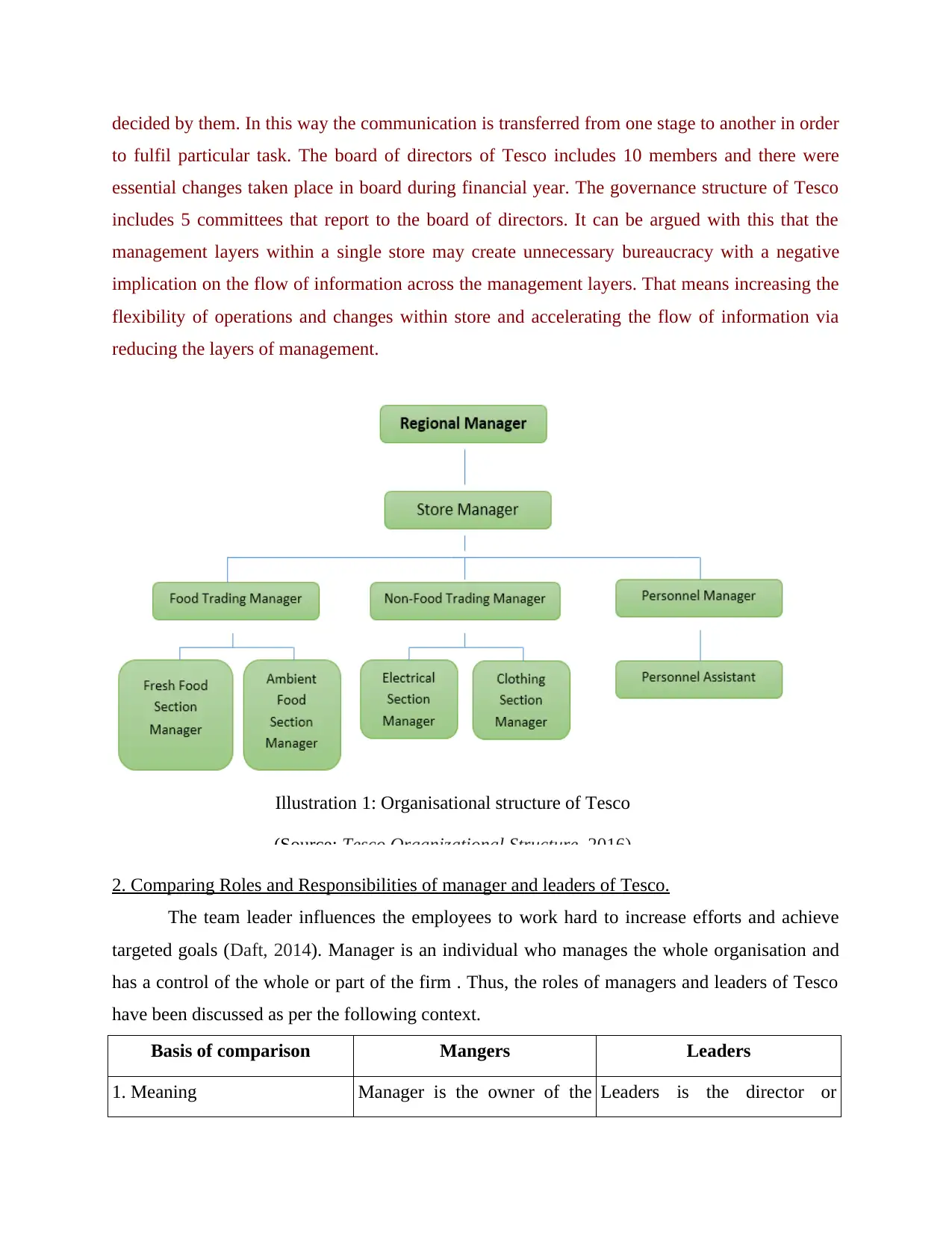
decided by them. In this way the communication is transferred from one stage to another in order
to fulfil particular task. The board of directors of Tesco includes 10 members and there were
essential changes taken place in board during financial year. The governance structure of Tesco
includes 5 committees that report to the board of directors. It can be argued with this that the
management layers within a single store may create unnecessary bureaucracy with a negative
implication on the flow of information across the management layers. That means increasing the
flexibility of operations and changes within store and accelerating the flow of information via
reducing the layers of management.
Illustration 1: Organisational structure of Tesco
(Source: Tesco Organizational Structure, 2016)
2. Comparing Roles and Responsibilities of manager and leaders of Tesco.
The team leader influences the employees to work hard to increase efforts and achieve
targeted goals (Daft, 2014). Manager is an individual who manages the whole organisation and
has a control of the whole or part of the firm . Thus, the roles of managers and leaders of Tesco
have been discussed as per the following context.
Basis of comparison Mangers Leaders
1. Meaning Manager is the owner of the Leaders is the director or
to fulfil particular task. The board of directors of Tesco includes 10 members and there were
essential changes taken place in board during financial year. The governance structure of Tesco
includes 5 committees that report to the board of directors. It can be argued with this that the
management layers within a single store may create unnecessary bureaucracy with a negative
implication on the flow of information across the management layers. That means increasing the
flexibility of operations and changes within store and accelerating the flow of information via
reducing the layers of management.
Illustration 1: Organisational structure of Tesco
(Source: Tesco Organizational Structure, 2016)
2. Comparing Roles and Responsibilities of manager and leaders of Tesco.
The team leader influences the employees to work hard to increase efforts and achieve
targeted goals (Daft, 2014). Manager is an individual who manages the whole organisation and
has a control of the whole or part of the firm . Thus, the roles of managers and leaders of Tesco
have been discussed as per the following context.
Basis of comparison Mangers Leaders
1. Meaning Manager is the owner of the Leaders is the director or

company. guider of the followers.
2. Work done Managers order leaders to
work and have people who
work for them.
Leaders guides the employees
about the work given by
manager and have people who
follows them.
3. Ability Managers have the ability to
direct the leaders about day to
day works and review
resources that are needed in
the firm .
The leaders of Tesco have the
ability to make the team
members work which helps in
increasing efficiency.
4. Objectives achieved Managers of Tesco organise
human and physical resources
to achieve the objectives of
business.
Leaders of the selected
company develops followers
by coaching them and treating
with respect. In order to
achieve objectives leaders
challenge the followers to
work with enthusiasm.
5. Task allocation and
delegation.
The manager of cited company
needs to coordinate with the
leaders and allocate task
accordingly to each leader.
The task allocation vary
according to the employees
and the followers has to
implement on it as per the
variations.
From this, it has been analysed that both managers and leaders plays significant role in
Tesco. Manager is an individual that owns the company and Leader is an individual that directs
or guides the followers. Both are equally important to achieve long term success and high brand
image by selling products to potential customers that helps in raising rate of profit of Tesco.
2. Work done Managers order leaders to
work and have people who
work for them.
Leaders guides the employees
about the work given by
manager and have people who
follows them.
3. Ability Managers have the ability to
direct the leaders about day to
day works and review
resources that are needed in
the firm .
The leaders of Tesco have the
ability to make the team
members work which helps in
increasing efficiency.
4. Objectives achieved Managers of Tesco organise
human and physical resources
to achieve the objectives of
business.
Leaders of the selected
company develops followers
by coaching them and treating
with respect. In order to
achieve objectives leaders
challenge the followers to
work with enthusiasm.
5. Task allocation and
delegation.
The manager of cited company
needs to coordinate with the
leaders and allocate task
accordingly to each leader.
The task allocation vary
according to the employees
and the followers has to
implement on it as per the
variations.
From this, it has been analysed that both managers and leaders plays significant role in
Tesco. Manager is an individual that owns the company and Leader is an individual that directs
or guides the followers. Both are equally important to achieve long term success and high brand
image by selling products to potential customers that helps in raising rate of profit of Tesco.
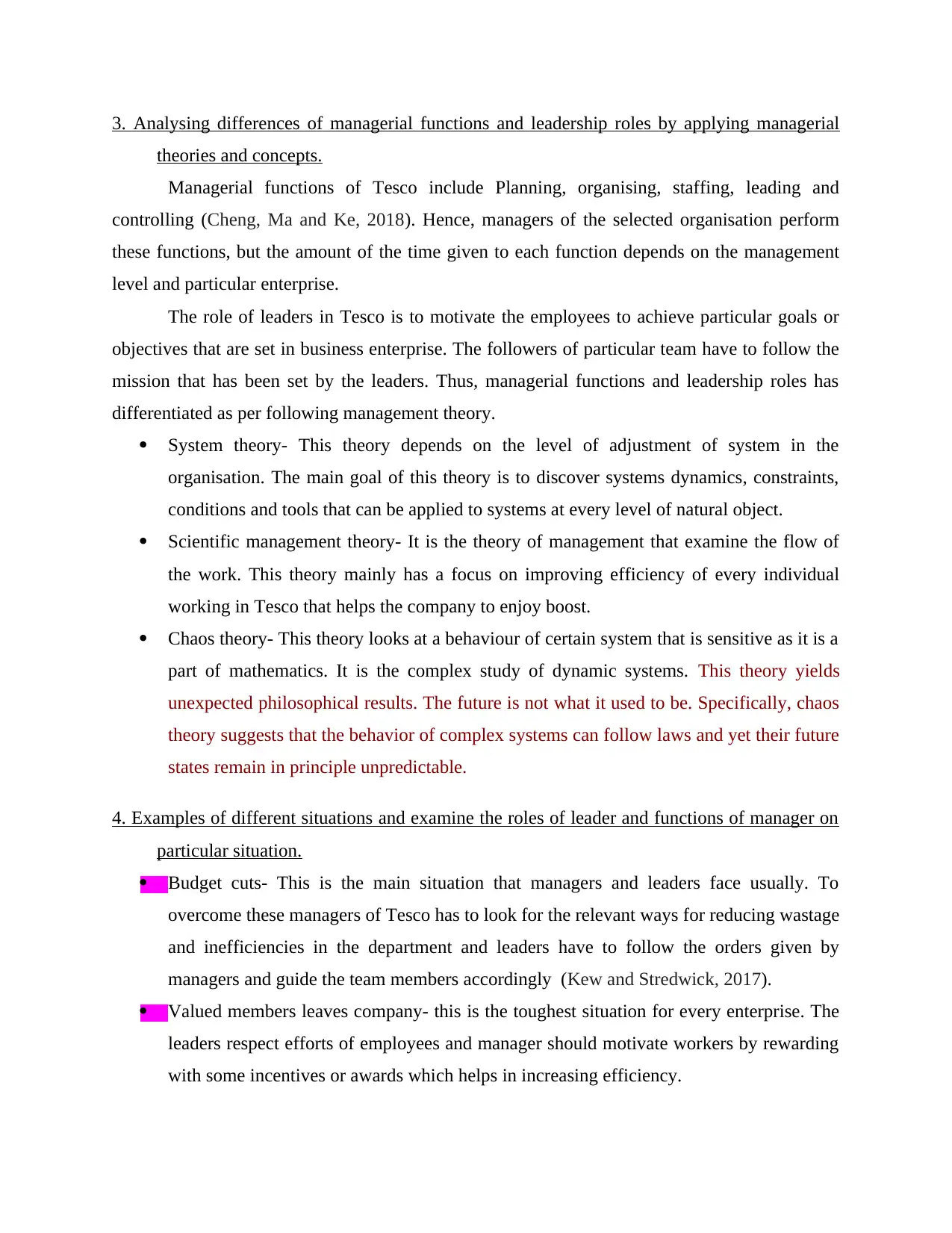
3. Analysing differences of managerial functions and leadership roles by applying managerial
theories and concepts.
Managerial functions of Tesco include Planning, organising, staffing, leading and
controlling (Cheng, Ma and Ke, 2018). Hence, managers of the selected organisation perform
these functions, but the amount of the time given to each function depends on the management
level and particular enterprise.
The role of leaders in Tesco is to motivate the employees to achieve particular goals or
objectives that are set in business enterprise. The followers of particular team have to follow the
mission that has been set by the leaders. Thus, managerial functions and leadership roles has
differentiated as per following management theory.
System theory- This theory depends on the level of adjustment of system in the
organisation. The main goal of this theory is to discover systems dynamics, constraints,
conditions and tools that can be applied to systems at every level of natural object.
Scientific management theory- It is the theory of management that examine the flow of
the work. This theory mainly has a focus on improving efficiency of every individual
working in Tesco that helps the company to enjoy boost.
Chaos theory- This theory looks at a behaviour of certain system that is sensitive as it is a
part of mathematics. It is the complex study of dynamic systems. This theory yields
unexpected philosophical results. The future is not what it used to be. Specifically, chaos
theory suggests that the behavior of complex systems can follow laws and yet their future
states remain in principle unpredictable.
4. Examples of different situations and examine the roles of leader and functions of manager on
particular situation.
Budget cuts- This is the main situation that managers and leaders face usually. To
overcome these managers of Tesco has to look for the relevant ways for reducing wastage
and inefficiencies in the department and leaders have to follow the orders given by
managers and guide the team members accordingly (Kew and Stredwick, 2017).
Valued members leaves company- this is the toughest situation for every enterprise. The
leaders respect efforts of employees and manager should motivate workers by rewarding
with some incentives or awards which helps in increasing efficiency.
theories and concepts.
Managerial functions of Tesco include Planning, organising, staffing, leading and
controlling (Cheng, Ma and Ke, 2018). Hence, managers of the selected organisation perform
these functions, but the amount of the time given to each function depends on the management
level and particular enterprise.
The role of leaders in Tesco is to motivate the employees to achieve particular goals or
objectives that are set in business enterprise. The followers of particular team have to follow the
mission that has been set by the leaders. Thus, managerial functions and leadership roles has
differentiated as per following management theory.
System theory- This theory depends on the level of adjustment of system in the
organisation. The main goal of this theory is to discover systems dynamics, constraints,
conditions and tools that can be applied to systems at every level of natural object.
Scientific management theory- It is the theory of management that examine the flow of
the work. This theory mainly has a focus on improving efficiency of every individual
working in Tesco that helps the company to enjoy boost.
Chaos theory- This theory looks at a behaviour of certain system that is sensitive as it is a
part of mathematics. It is the complex study of dynamic systems. This theory yields
unexpected philosophical results. The future is not what it used to be. Specifically, chaos
theory suggests that the behavior of complex systems can follow laws and yet their future
states remain in principle unpredictable.
4. Examples of different situations and examine the roles of leader and functions of manager on
particular situation.
Budget cuts- This is the main situation that managers and leaders face usually. To
overcome these managers of Tesco has to look for the relevant ways for reducing wastage
and inefficiencies in the department and leaders have to follow the orders given by
managers and guide the team members accordingly (Kew and Stredwick, 2017).
Valued members leaves company- this is the toughest situation for every enterprise. The
leaders respect efforts of employees and manager should motivate workers by rewarding
with some incentives or awards which helps in increasing efficiency.
Paraphrase This Document
Need a fresh take? Get an instant paraphrase of this document with our AI Paraphraser
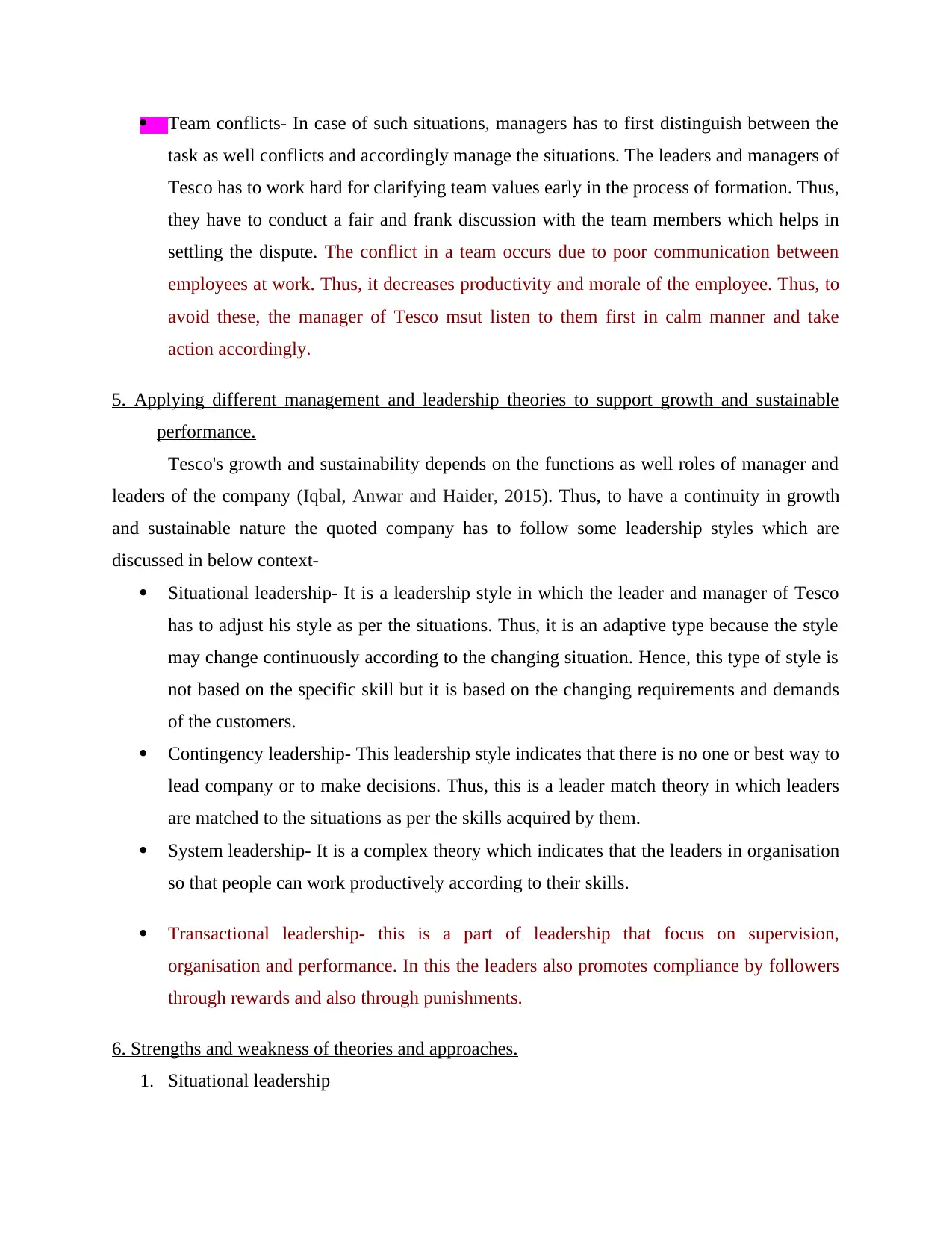
Team conflicts- In case of such situations, managers has to first distinguish between the
task as well conflicts and accordingly manage the situations. The leaders and managers of
Tesco has to work hard for clarifying team values early in the process of formation. Thus,
they have to conduct a fair and frank discussion with the team members which helps in
settling the dispute. The conflict in a team occurs due to poor communication between
employees at work. Thus, it decreases productivity and morale of the employee. Thus, to
avoid these, the manager of Tesco msut listen to them first in calm manner and take
action accordingly.
5. Applying different management and leadership theories to support growth and sustainable
performance.
Tesco's growth and sustainability depends on the functions as well roles of manager and
leaders of the company (Iqbal, Anwar and Haider, 2015). Thus, to have a continuity in growth
and sustainable nature the quoted company has to follow some leadership styles which are
discussed in below context-
Situational leadership- It is a leadership style in which the leader and manager of Tesco
has to adjust his style as per the situations. Thus, it is an adaptive type because the style
may change continuously according to the changing situation. Hence, this type of style is
not based on the specific skill but it is based on the changing requirements and demands
of the customers.
Contingency leadership- This leadership style indicates that there is no one or best way to
lead company or to make decisions. Thus, this is a leader match theory in which leaders
are matched to the situations as per the skills acquired by them.
System leadership- It is a complex theory which indicates that the leaders in organisation
so that people can work productively according to their skills.
Transactional leadership- this is a part of leadership that focus on supervision,
organisation and performance. In this the leaders also promotes compliance by followers
through rewards and also through punishments.
6. Strengths and weakness of theories and approaches.
1. Situational leadership
task as well conflicts and accordingly manage the situations. The leaders and managers of
Tesco has to work hard for clarifying team values early in the process of formation. Thus,
they have to conduct a fair and frank discussion with the team members which helps in
settling the dispute. The conflict in a team occurs due to poor communication between
employees at work. Thus, it decreases productivity and morale of the employee. Thus, to
avoid these, the manager of Tesco msut listen to them first in calm manner and take
action accordingly.
5. Applying different management and leadership theories to support growth and sustainable
performance.
Tesco's growth and sustainability depends on the functions as well roles of manager and
leaders of the company (Iqbal, Anwar and Haider, 2015). Thus, to have a continuity in growth
and sustainable nature the quoted company has to follow some leadership styles which are
discussed in below context-
Situational leadership- It is a leadership style in which the leader and manager of Tesco
has to adjust his style as per the situations. Thus, it is an adaptive type because the style
may change continuously according to the changing situation. Hence, this type of style is
not based on the specific skill but it is based on the changing requirements and demands
of the customers.
Contingency leadership- This leadership style indicates that there is no one or best way to
lead company or to make decisions. Thus, this is a leader match theory in which leaders
are matched to the situations as per the skills acquired by them.
System leadership- It is a complex theory which indicates that the leaders in organisation
so that people can work productively according to their skills.
Transactional leadership- this is a part of leadership that focus on supervision,
organisation and performance. In this the leaders also promotes compliance by followers
through rewards and also through punishments.
6. Strengths and weakness of theories and approaches.
1. Situational leadership
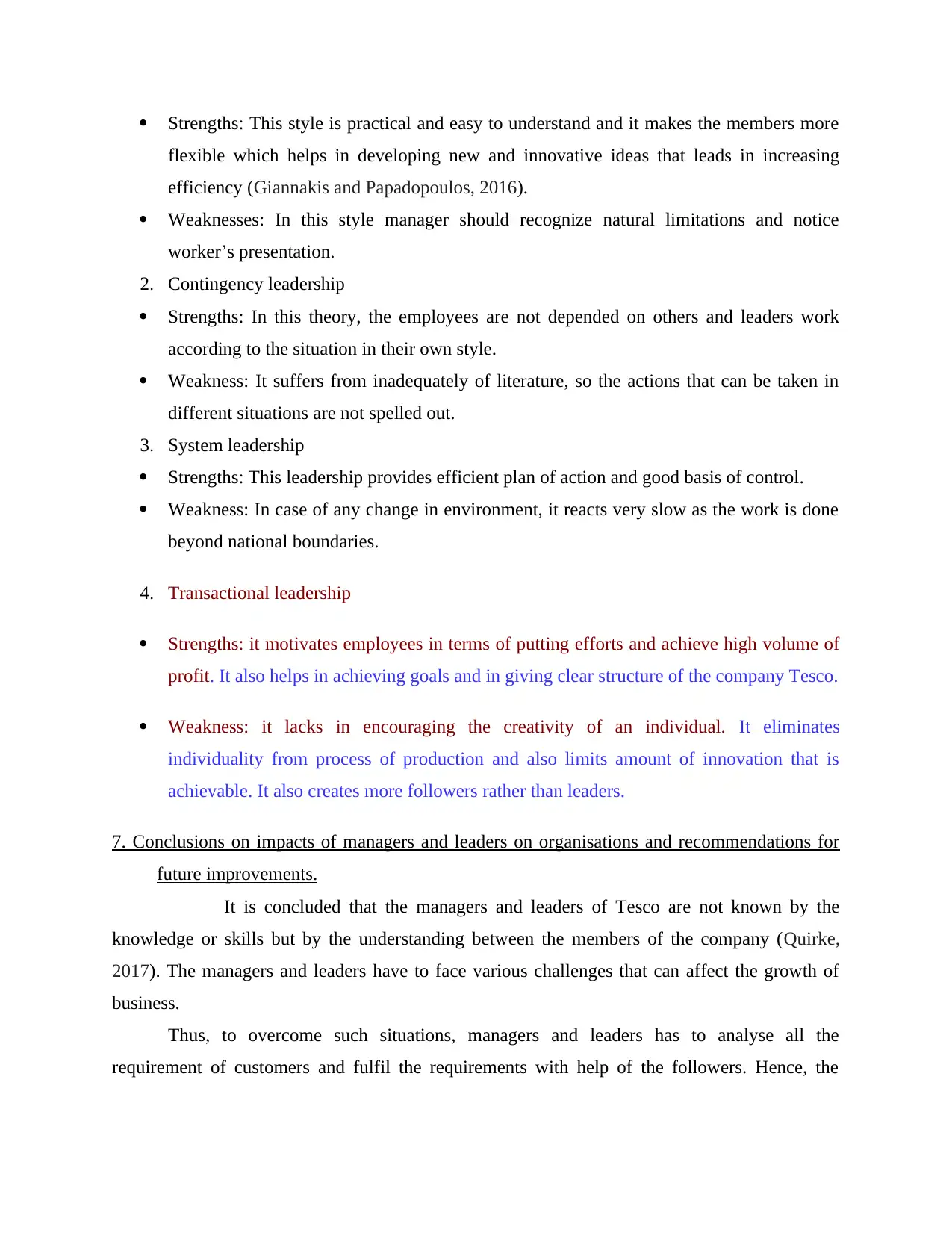
Strengths: This style is practical and easy to understand and it makes the members more
flexible which helps in developing new and innovative ideas that leads in increasing
efficiency (Giannakis and Papadopoulos, 2016).
Weaknesses: In this style manager should recognize natural limitations and notice
worker’s presentation.
2. Contingency leadership
Strengths: In this theory, the employees are not depended on others and leaders work
according to the situation in their own style.
Weakness: It suffers from inadequately of literature, so the actions that can be taken in
different situations are not spelled out.
3. System leadership
Strengths: This leadership provides efficient plan of action and good basis of control.
Weakness: In case of any change in environment, it reacts very slow as the work is done
beyond national boundaries.
4. Transactional leadership
Strengths: it motivates employees in terms of putting efforts and achieve high volume of
profit. It also helps in achieving goals and in giving clear structure of the company Tesco.
Weakness: it lacks in encouraging the creativity of an individual. It eliminates
individuality from process of production and also limits amount of innovation that is
achievable. It also creates more followers rather than leaders.
7. Conclusions on impacts of managers and leaders on organisations and recommendations for
future improvements.
It is concluded that the managers and leaders of Tesco are not known by the
knowledge or skills but by the understanding between the members of the company (Quirke,
2017). The managers and leaders have to face various challenges that can affect the growth of
business.
Thus, to overcome such situations, managers and leaders has to analyse all the
requirement of customers and fulfil the requirements with help of the followers. Hence, the
flexible which helps in developing new and innovative ideas that leads in increasing
efficiency (Giannakis and Papadopoulos, 2016).
Weaknesses: In this style manager should recognize natural limitations and notice
worker’s presentation.
2. Contingency leadership
Strengths: In this theory, the employees are not depended on others and leaders work
according to the situation in their own style.
Weakness: It suffers from inadequately of literature, so the actions that can be taken in
different situations are not spelled out.
3. System leadership
Strengths: This leadership provides efficient plan of action and good basis of control.
Weakness: In case of any change in environment, it reacts very slow as the work is done
beyond national boundaries.
4. Transactional leadership
Strengths: it motivates employees in terms of putting efforts and achieve high volume of
profit. It also helps in achieving goals and in giving clear structure of the company Tesco.
Weakness: it lacks in encouraging the creativity of an individual. It eliminates
individuality from process of production and also limits amount of innovation that is
achievable. It also creates more followers rather than leaders.
7. Conclusions on impacts of managers and leaders on organisations and recommendations for
future improvements.
It is concluded that the managers and leaders of Tesco are not known by the
knowledge or skills but by the understanding between the members of the company (Quirke,
2017). The managers and leaders have to face various challenges that can affect the growth of
business.
Thus, to overcome such situations, managers and leaders has to analyse all the
requirement of customers and fulfil the requirements with help of the followers. Hence, the

followers must be motivated which helps them to put their efforts in increasing efficiency and
maximising profits.
For future improvements, Tesco has to build trust relationship with suppliers. Further,
they can provide more filtering or sorting options on their online websites so that it may not
create trouble for customers to go through many pages for results. They can also show delivery
charge on product pages as customers hate in finding charges of delievery at last minute of
purchase decision.
TASK 2
1. Introduction on operation management of Tesco and key approaches adopted.
The term operation management refers to the subject of business to make sure that the
business operations are effective and efficient is related with producing goods and services
(Rowley and Hartley, 2017). Thus, it plays a crucial role in improving productivity of Tesco and
helps in maintaining design and operations that is used for attracting customers. The members in
Tesco are trained in such a way which helps them to take sudden decision as per the need arises.
Hence, Tesco adopted various measures as, the supply speed and quality has been
updated which attract the customers and enjoy well and high quality goods.
Quality management approach is adopted by Tesco. Thus, to maintain a quality of the
product is an important key approaches that has to be followed by Tesco (Coughlan and et.al.,
2016). Hence, global competition is increasing, the company has to increase the quality of the
product to target the customer's attraction that later leads in increasing goodwill. The main
motive of this approach is to maintain the quality or increase the quality of goods and services
provided by Tesco so that it attracts large number of customers towards the company. It also
seeks in improving quality and also takes into account all measures related to quality that are
taken at all levels and also involve employees of all companies. This helps Tesco in achieving
long term success and huge brand image.
2. Roles and responsibilities of managers and leaders in successful management of operation.
Roles of managers- the manager is the person that directs the whole activities of
organisation as well as the members involved in particular organisation. The success of
maximising profits.
For future improvements, Tesco has to build trust relationship with suppliers. Further,
they can provide more filtering or sorting options on their online websites so that it may not
create trouble for customers to go through many pages for results. They can also show delivery
charge on product pages as customers hate in finding charges of delievery at last minute of
purchase decision.
TASK 2
1. Introduction on operation management of Tesco and key approaches adopted.
The term operation management refers to the subject of business to make sure that the
business operations are effective and efficient is related with producing goods and services
(Rowley and Hartley, 2017). Thus, it plays a crucial role in improving productivity of Tesco and
helps in maintaining design and operations that is used for attracting customers. The members in
Tesco are trained in such a way which helps them to take sudden decision as per the need arises.
Hence, Tesco adopted various measures as, the supply speed and quality has been
updated which attract the customers and enjoy well and high quality goods.
Quality management approach is adopted by Tesco. Thus, to maintain a quality of the
product is an important key approaches that has to be followed by Tesco (Coughlan and et.al.,
2016). Hence, global competition is increasing, the company has to increase the quality of the
product to target the customer's attraction that later leads in increasing goodwill. The main
motive of this approach is to maintain the quality or increase the quality of goods and services
provided by Tesco so that it attracts large number of customers towards the company. It also
seeks in improving quality and also takes into account all measures related to quality that are
taken at all levels and also involve employees of all companies. This helps Tesco in achieving
long term success and huge brand image.
2. Roles and responsibilities of managers and leaders in successful management of operation.
Roles of managers- the manager is the person that directs the whole activities of
organisation as well as the members involved in particular organisation. The success of
Secure Best Marks with AI Grader
Need help grading? Try our AI Grader for instant feedback on your assignments.
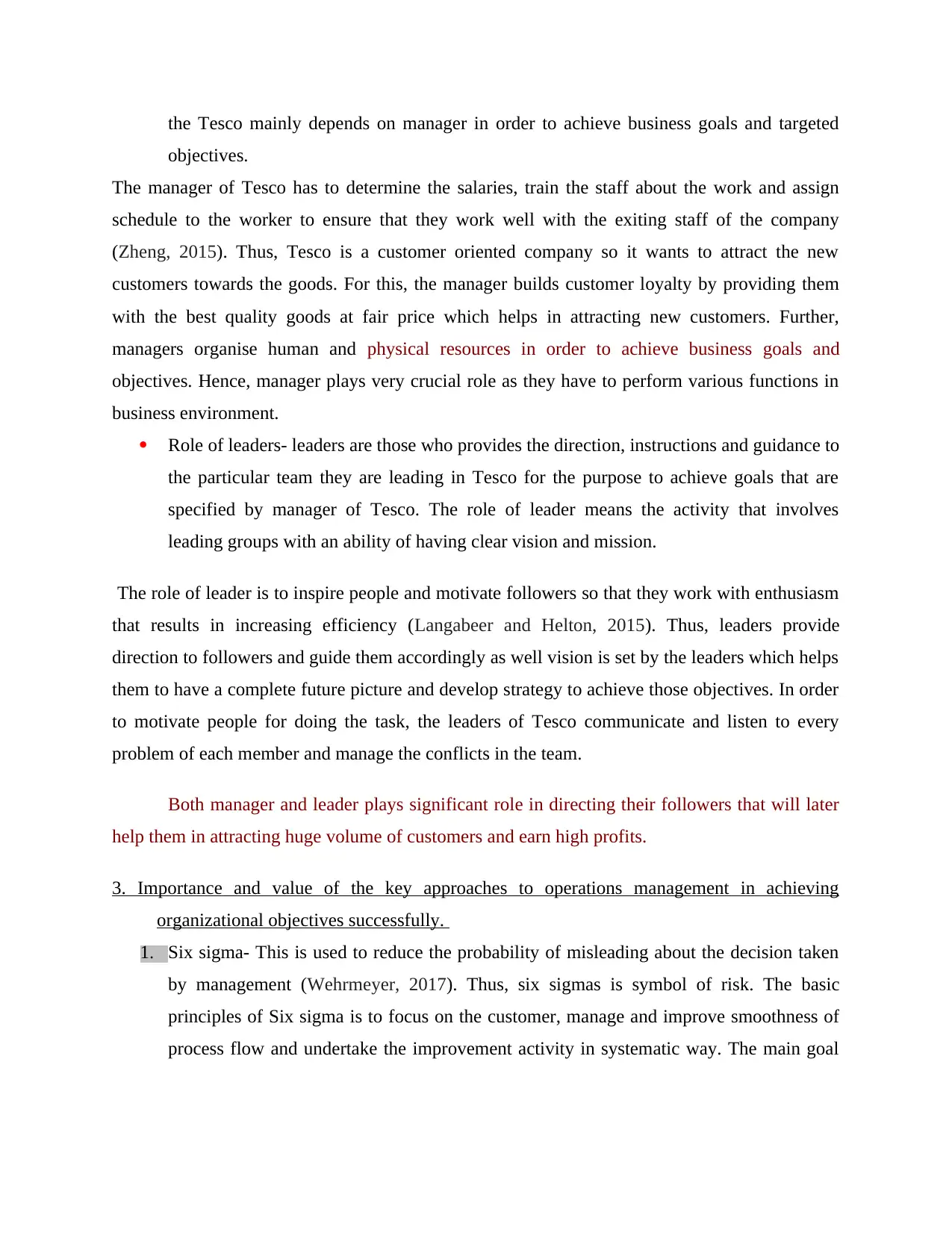
the Tesco mainly depends on manager in order to achieve business goals and targeted
objectives.
The manager of Tesco has to determine the salaries, train the staff about the work and assign
schedule to the worker to ensure that they work well with the exiting staff of the company
(Zheng, 2015). Thus, Tesco is a customer oriented company so it wants to attract the new
customers towards the goods. For this, the manager builds customer loyalty by providing them
with the best quality goods at fair price which helps in attracting new customers. Further,
managers organise human and physical resources in order to achieve business goals and
objectives. Hence, manager plays very crucial role as they have to perform various functions in
business environment.
Role of leaders- leaders are those who provides the direction, instructions and guidance to
the particular team they are leading in Tesco for the purpose to achieve goals that are
specified by manager of Tesco. The role of leader means the activity that involves
leading groups with an ability of having clear vision and mission.
The role of leader is to inspire people and motivate followers so that they work with enthusiasm
that results in increasing efficiency (Langabeer and Helton, 2015). Thus, leaders provide
direction to followers and guide them accordingly as well vision is set by the leaders which helps
them to have a complete future picture and develop strategy to achieve those objectives. In order
to motivate people for doing the task, the leaders of Tesco communicate and listen to every
problem of each member and manage the conflicts in the team.
Both manager and leader plays significant role in directing their followers that will later
help them in attracting huge volume of customers and earn high profits.
3. Importance and value of the key approaches to operations management in achieving
organizational objectives successfully.
1. Six sigma- This is used to reduce the probability of misleading about the decision taken
by management (Wehrmeyer, 2017). Thus, six sigmas is symbol of risk. The basic
principles of Six sigma is to focus on the customer, manage and improve smoothness of
process flow and undertake the improvement activity in systematic way. The main goal
objectives.
The manager of Tesco has to determine the salaries, train the staff about the work and assign
schedule to the worker to ensure that they work well with the exiting staff of the company
(Zheng, 2015). Thus, Tesco is a customer oriented company so it wants to attract the new
customers towards the goods. For this, the manager builds customer loyalty by providing them
with the best quality goods at fair price which helps in attracting new customers. Further,
managers organise human and physical resources in order to achieve business goals and
objectives. Hence, manager plays very crucial role as they have to perform various functions in
business environment.
Role of leaders- leaders are those who provides the direction, instructions and guidance to
the particular team they are leading in Tesco for the purpose to achieve goals that are
specified by manager of Tesco. The role of leader means the activity that involves
leading groups with an ability of having clear vision and mission.
The role of leader is to inspire people and motivate followers so that they work with enthusiasm
that results in increasing efficiency (Langabeer and Helton, 2015). Thus, leaders provide
direction to followers and guide them accordingly as well vision is set by the leaders which helps
them to have a complete future picture and develop strategy to achieve those objectives. In order
to motivate people for doing the task, the leaders of Tesco communicate and listen to every
problem of each member and manage the conflicts in the team.
Both manager and leader plays significant role in directing their followers that will later
help them in attracting huge volume of customers and earn high profits.
3. Importance and value of the key approaches to operations management in achieving
organizational objectives successfully.
1. Six sigma- This is used to reduce the probability of misleading about the decision taken
by management (Wehrmeyer, 2017). Thus, six sigmas is symbol of risk. The basic
principles of Six sigma is to focus on the customer, manage and improve smoothness of
process flow and undertake the improvement activity in systematic way. The main goal
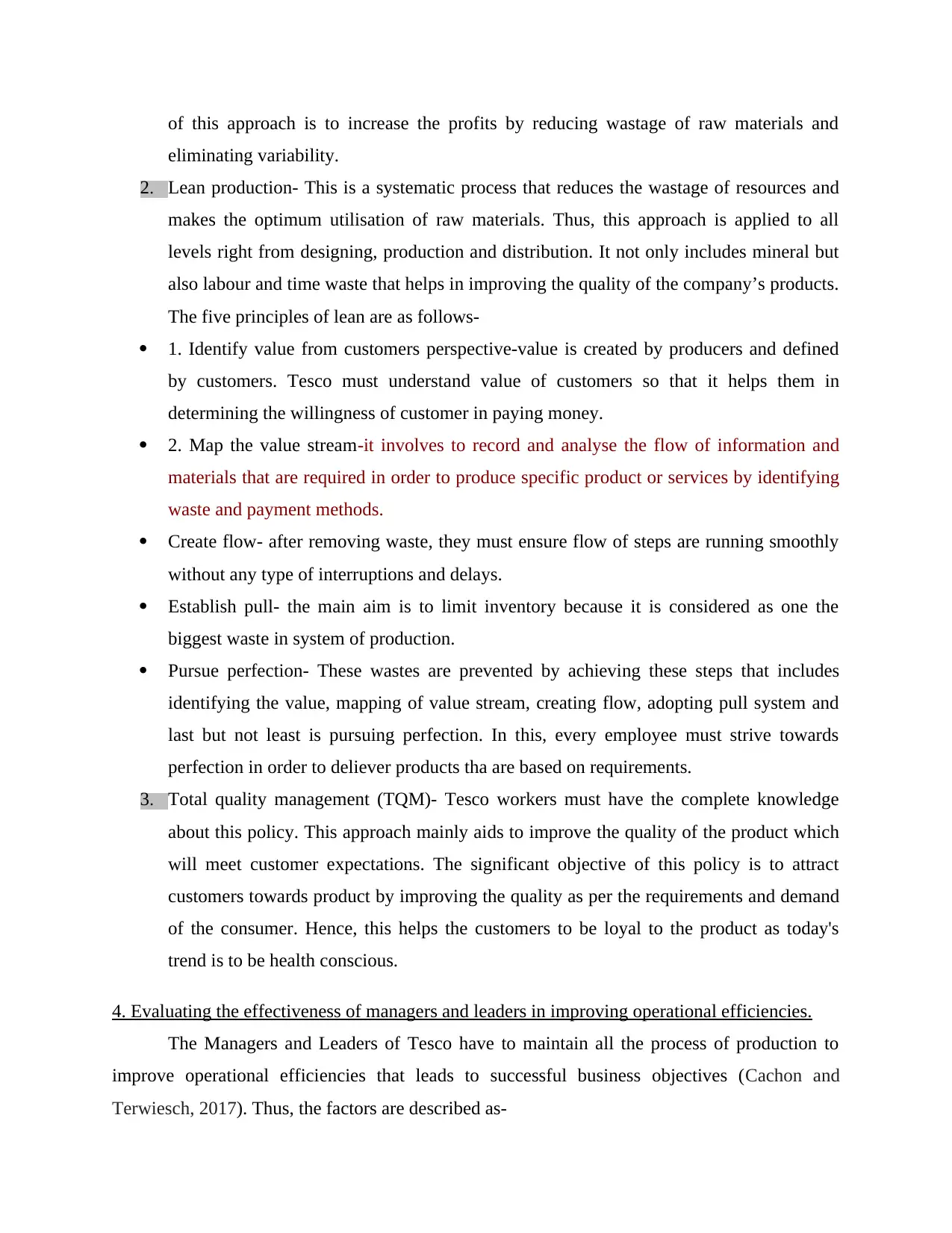
of this approach is to increase the profits by reducing wastage of raw materials and
eliminating variability.
2. Lean production- This is a systematic process that reduces the wastage of resources and
makes the optimum utilisation of raw materials. Thus, this approach is applied to all
levels right from designing, production and distribution. It not only includes mineral but
also labour and time waste that helps in improving the quality of the company’s products.
The five principles of lean are as follows-
1. Identify value from customers perspective-value is created by producers and defined
by customers. Tesco must understand value of customers so that it helps them in
determining the willingness of customer in paying money.
2. Map the value stream-it involves to record and analyse the flow of information and
materials that are required in order to produce specific product or services by identifying
waste and payment methods.
Create flow- after removing waste, they must ensure flow of steps are running smoothly
without any type of interruptions and delays.
Establish pull- the main aim is to limit inventory because it is considered as one the
biggest waste in system of production.
Pursue perfection- These wastes are prevented by achieving these steps that includes
identifying the value, mapping of value stream, creating flow, adopting pull system and
last but not least is pursuing perfection. In this, every employee must strive towards
perfection in order to deliever products tha are based on requirements.
3. Total quality management (TQM)- Tesco workers must have the complete knowledge
about this policy. This approach mainly aids to improve the quality of the product which
will meet customer expectations. The significant objective of this policy is to attract
customers towards product by improving the quality as per the requirements and demand
of the consumer. Hence, this helps the customers to be loyal to the product as today's
trend is to be health conscious.
4. Evaluating the effectiveness of managers and leaders in improving operational efficiencies.
The Managers and Leaders of Tesco have to maintain all the process of production to
improve operational efficiencies that leads to successful business objectives (Cachon and
Terwiesch, 2017). Thus, the factors are described as-
eliminating variability.
2. Lean production- This is a systematic process that reduces the wastage of resources and
makes the optimum utilisation of raw materials. Thus, this approach is applied to all
levels right from designing, production and distribution. It not only includes mineral but
also labour and time waste that helps in improving the quality of the company’s products.
The five principles of lean are as follows-
1. Identify value from customers perspective-value is created by producers and defined
by customers. Tesco must understand value of customers so that it helps them in
determining the willingness of customer in paying money.
2. Map the value stream-it involves to record and analyse the flow of information and
materials that are required in order to produce specific product or services by identifying
waste and payment methods.
Create flow- after removing waste, they must ensure flow of steps are running smoothly
without any type of interruptions and delays.
Establish pull- the main aim is to limit inventory because it is considered as one the
biggest waste in system of production.
Pursue perfection- These wastes are prevented by achieving these steps that includes
identifying the value, mapping of value stream, creating flow, adopting pull system and
last but not least is pursuing perfection. In this, every employee must strive towards
perfection in order to deliever products tha are based on requirements.
3. Total quality management (TQM)- Tesco workers must have the complete knowledge
about this policy. This approach mainly aids to improve the quality of the product which
will meet customer expectations. The significant objective of this policy is to attract
customers towards product by improving the quality as per the requirements and demand
of the consumer. Hence, this helps the customers to be loyal to the product as today's
trend is to be health conscious.
4. Evaluating the effectiveness of managers and leaders in improving operational efficiencies.
The Managers and Leaders of Tesco have to maintain all the process of production to
improve operational efficiencies that leads to successful business objectives (Cachon and
Terwiesch, 2017). Thus, the factors are described as-

Supply chain management- It is the management which includes entire process from start
to end that details about the consumers getting the product (Wong and et.al., 2015). Thus,
it involves the procurement, storing, transportation and delivering of goods. Thus, this
help in delivering right products at correct place without any delay and customers will be
attracted towards the service that leads to maximisation of profits.
Transformation of raw materials to finished goods-it is a crucial part in Tesco. As the
manager of the selected company plans the transformation process and directs the leaders
to work accordingly. The followers of the particular team transform the raw materials
into finished goods which attracts the customers towards the particular product that helps
in increasing productivity and company enjoys profit.
Designing the process- The process must be designed so well that the customer is
attracted towards it and they enjoy the journey right from selecting the product they
desire till the time they purchase it. This helps the customers to be loyal towards the
product which results in maximising goodwill and profits. Hence, managers can bring
changes in procedures in order to provide the customer an ease to buy the particular
product.
Quality control- Quality is something more than just the assurance about particular
product that it reaches customers’ expectations (Coughlan and et.al., 2016). In order to
increase the loyalty in customers, managers and leaders of Tesco has to control or
improve the quality of the products which helps them to be loyal and happy.
Inventory control- It is one of the most difficult system in every type of business.
Inventory control is important because the time limit of the consumers’ desire for the
product is sometimes less than the time taken in production and delivering the particular
product.
5. Impact of external business environment factors on operational management decisions by
leaders and managers and analysing how these factors affect business environment.
External factors of business are those that affects the internal functions of business like
the objectives of the firm or its strategy to increase the growth of Tesco (Hill and Hill, 2017).
Thus, external factors that affect the business are explained as per the below context-
Political factors- This includes government policy that and laws that affects the
operations of business positively or negatively. Thus, if there is change in the government
to end that details about the consumers getting the product (Wong and et.al., 2015). Thus,
it involves the procurement, storing, transportation and delivering of goods. Thus, this
help in delivering right products at correct place without any delay and customers will be
attracted towards the service that leads to maximisation of profits.
Transformation of raw materials to finished goods-it is a crucial part in Tesco. As the
manager of the selected company plans the transformation process and directs the leaders
to work accordingly. The followers of the particular team transform the raw materials
into finished goods which attracts the customers towards the particular product that helps
in increasing productivity and company enjoys profit.
Designing the process- The process must be designed so well that the customer is
attracted towards it and they enjoy the journey right from selecting the product they
desire till the time they purchase it. This helps the customers to be loyal towards the
product which results in maximising goodwill and profits. Hence, managers can bring
changes in procedures in order to provide the customer an ease to buy the particular
product.
Quality control- Quality is something more than just the assurance about particular
product that it reaches customers’ expectations (Coughlan and et.al., 2016). In order to
increase the loyalty in customers, managers and leaders of Tesco has to control or
improve the quality of the products which helps them to be loyal and happy.
Inventory control- It is one of the most difficult system in every type of business.
Inventory control is important because the time limit of the consumers’ desire for the
product is sometimes less than the time taken in production and delivering the particular
product.
5. Impact of external business environment factors on operational management decisions by
leaders and managers and analysing how these factors affect business environment.
External factors of business are those that affects the internal functions of business like
the objectives of the firm or its strategy to increase the growth of Tesco (Hill and Hill, 2017).
Thus, external factors that affect the business are explained as per the below context-
Political factors- This includes government policy that and laws that affects the
operations of business positively or negatively. Thus, if there is change in the government
Paraphrase This Document
Need a fresh take? Get an instant paraphrase of this document with our AI Paraphraser
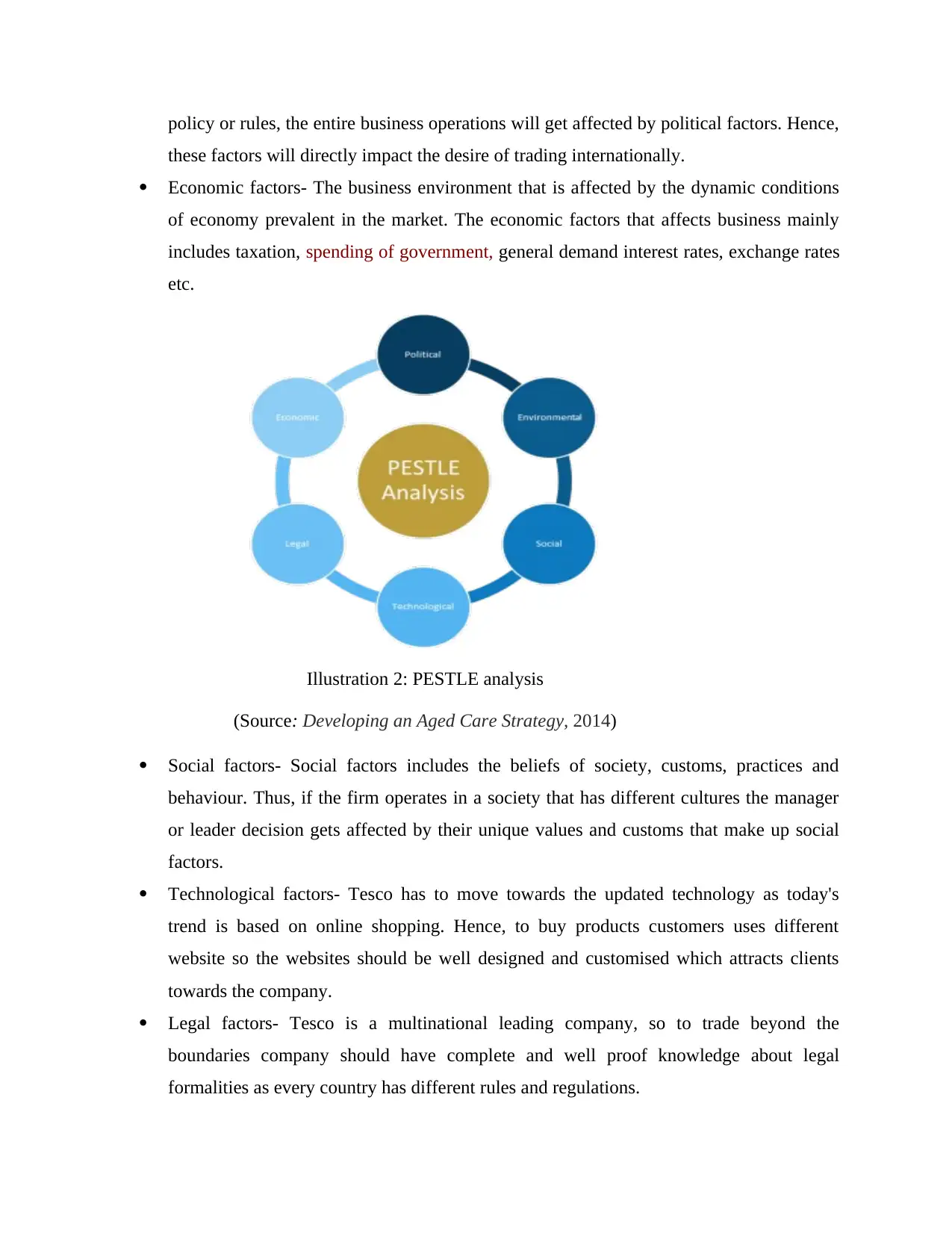
policy or rules, the entire business operations will get affected by political factors. Hence,
these factors will directly impact the desire of trading internationally.
Economic factors- The business environment that is affected by the dynamic conditions
of economy prevalent in the market. The economic factors that affects business mainly
includes taxation, spending of government, general demand interest rates, exchange rates
etc.
Illustration 2: PESTLE analysis
(Source: Developing an Aged Care Strategy, 2014)
Social factors- Social factors includes the beliefs of society, customs, practices and
behaviour. Thus, if the firm operates in a society that has different cultures the manager
or leader decision gets affected by their unique values and customs that make up social
factors.
Technological factors- Tesco has to move towards the updated technology as today's
trend is based on online shopping. Hence, to buy products customers uses different
website so the websites should be well designed and customised which attracts clients
towards the company.
Legal factors- Tesco is a multinational leading company, so to trade beyond the
boundaries company should have complete and well proof knowledge about legal
formalities as every country has different rules and regulations.
these factors will directly impact the desire of trading internationally.
Economic factors- The business environment that is affected by the dynamic conditions
of economy prevalent in the market. The economic factors that affects business mainly
includes taxation, spending of government, general demand interest rates, exchange rates
etc.
Illustration 2: PESTLE analysis
(Source: Developing an Aged Care Strategy, 2014)
Social factors- Social factors includes the beliefs of society, customs, practices and
behaviour. Thus, if the firm operates in a society that has different cultures the manager
or leader decision gets affected by their unique values and customs that make up social
factors.
Technological factors- Tesco has to move towards the updated technology as today's
trend is based on online shopping. Hence, to buy products customers uses different
website so the websites should be well designed and customised which attracts clients
towards the company.
Legal factors- Tesco is a multinational leading company, so to trade beyond the
boundaries company should have complete and well proof knowledge about legal
formalities as every country has different rules and regulations.
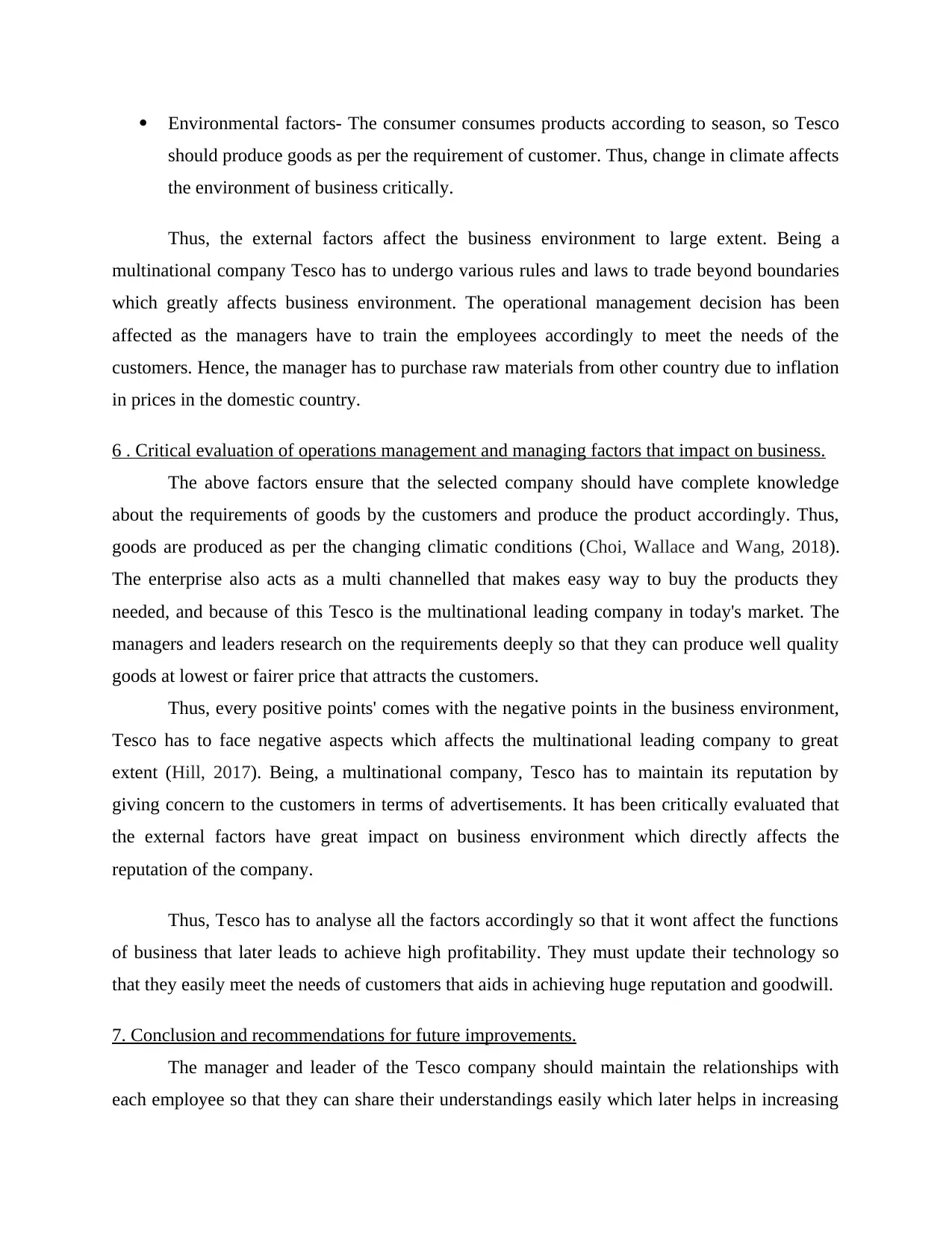
Environmental factors- The consumer consumes products according to season, so Tesco
should produce goods as per the requirement of customer. Thus, change in climate affects
the environment of business critically.
Thus, the external factors affect the business environment to large extent. Being a
multinational company Tesco has to undergo various rules and laws to trade beyond boundaries
which greatly affects business environment. The operational management decision has been
affected as the managers have to train the employees accordingly to meet the needs of the
customers. Hence, the manager has to purchase raw materials from other country due to inflation
in prices in the domestic country.
6 . Critical evaluation of operations management and managing factors that impact on business.
The above factors ensure that the selected company should have complete knowledge
about the requirements of goods by the customers and produce the product accordingly. Thus,
goods are produced as per the changing climatic conditions (Choi, Wallace and Wang, 2018).
The enterprise also acts as a multi channelled that makes easy way to buy the products they
needed, and because of this Tesco is the multinational leading company in today's market. The
managers and leaders research on the requirements deeply so that they can produce well quality
goods at lowest or fairer price that attracts the customers.
Thus, every positive points' comes with the negative points in the business environment,
Tesco has to face negative aspects which affects the multinational leading company to great
extent (Hill, 2017). Being, a multinational company, Tesco has to maintain its reputation by
giving concern to the customers in terms of advertisements. It has been critically evaluated that
the external factors have great impact on business environment which directly affects the
reputation of the company.
Thus, Tesco has to analyse all the factors accordingly so that it wont affect the functions
of business that later leads to achieve high profitability. They must update their technology so
that they easily meet the needs of customers that aids in achieving huge reputation and goodwill.
7. Conclusion and recommendations for future improvements.
The manager and leader of the Tesco company should maintain the relationships with
each employee so that they can share their understandings easily which later helps in increasing
should produce goods as per the requirement of customer. Thus, change in climate affects
the environment of business critically.
Thus, the external factors affect the business environment to large extent. Being a
multinational company Tesco has to undergo various rules and laws to trade beyond boundaries
which greatly affects business environment. The operational management decision has been
affected as the managers have to train the employees accordingly to meet the needs of the
customers. Hence, the manager has to purchase raw materials from other country due to inflation
in prices in the domestic country.
6 . Critical evaluation of operations management and managing factors that impact on business.
The above factors ensure that the selected company should have complete knowledge
about the requirements of goods by the customers and produce the product accordingly. Thus,
goods are produced as per the changing climatic conditions (Choi, Wallace and Wang, 2018).
The enterprise also acts as a multi channelled that makes easy way to buy the products they
needed, and because of this Tesco is the multinational leading company in today's market. The
managers and leaders research on the requirements deeply so that they can produce well quality
goods at lowest or fairer price that attracts the customers.
Thus, every positive points' comes with the negative points in the business environment,
Tesco has to face negative aspects which affects the multinational leading company to great
extent (Hill, 2017). Being, a multinational company, Tesco has to maintain its reputation by
giving concern to the customers in terms of advertisements. It has been critically evaluated that
the external factors have great impact on business environment which directly affects the
reputation of the company.
Thus, Tesco has to analyse all the factors accordingly so that it wont affect the functions
of business that later leads to achieve high profitability. They must update their technology so
that they easily meet the needs of customers that aids in achieving huge reputation and goodwill.
7. Conclusion and recommendations for future improvements.
The manager and leader of the Tesco company should maintain the relationships with
each employee so that they can share their understandings easily which later helps in increasing
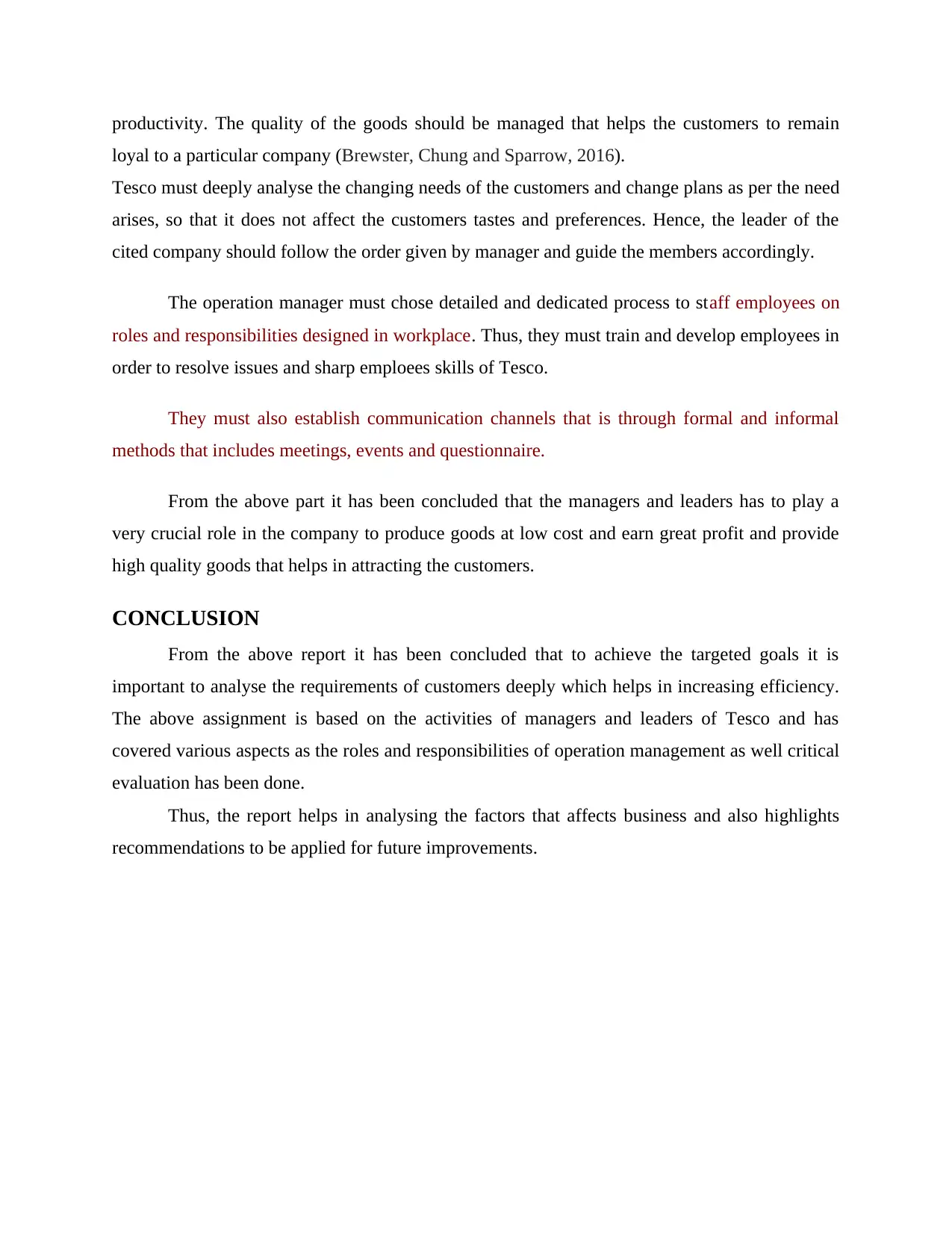
productivity. The quality of the goods should be managed that helps the customers to remain
loyal to a particular company (Brewster, Chung and Sparrow, 2016).
Tesco must deeply analyse the changing needs of the customers and change plans as per the need
arises, so that it does not affect the customers tastes and preferences. Hence, the leader of the
cited company should follow the order given by manager and guide the members accordingly.
The operation manager must chose detailed and dedicated process to staff employees on
roles and responsibilities designed in workplace. Thus, they must train and develop employees in
order to resolve issues and sharp emploees skills of Tesco.
They must also establish communication channels that is through formal and informal
methods that includes meetings, events and questionnaire.
From the above part it has been concluded that the managers and leaders has to play a
very crucial role in the company to produce goods at low cost and earn great profit and provide
high quality goods that helps in attracting the customers.
CONCLUSION
From the above report it has been concluded that to achieve the targeted goals it is
important to analyse the requirements of customers deeply which helps in increasing efficiency.
The above assignment is based on the activities of managers and leaders of Tesco and has
covered various aspects as the roles and responsibilities of operation management as well critical
evaluation has been done.
Thus, the report helps in analysing the factors that affects business and also highlights
recommendations to be applied for future improvements.
loyal to a particular company (Brewster, Chung and Sparrow, 2016).
Tesco must deeply analyse the changing needs of the customers and change plans as per the need
arises, so that it does not affect the customers tastes and preferences. Hence, the leader of the
cited company should follow the order given by manager and guide the members accordingly.
The operation manager must chose detailed and dedicated process to staff employees on
roles and responsibilities designed in workplace. Thus, they must train and develop employees in
order to resolve issues and sharp emploees skills of Tesco.
They must also establish communication channels that is through formal and informal
methods that includes meetings, events and questionnaire.
From the above part it has been concluded that the managers and leaders has to play a
very crucial role in the company to produce goods at low cost and earn great profit and provide
high quality goods that helps in attracting the customers.
CONCLUSION
From the above report it has been concluded that to achieve the targeted goals it is
important to analyse the requirements of customers deeply which helps in increasing efficiency.
The above assignment is based on the activities of managers and leaders of Tesco and has
covered various aspects as the roles and responsibilities of operation management as well critical
evaluation has been done.
Thus, the report helps in analysing the factors that affects business and also highlights
recommendations to be applied for future improvements.
Secure Best Marks with AI Grader
Need help grading? Try our AI Grader for instant feedback on your assignments.

REFERENCES
Books and Journal
Books and Journal

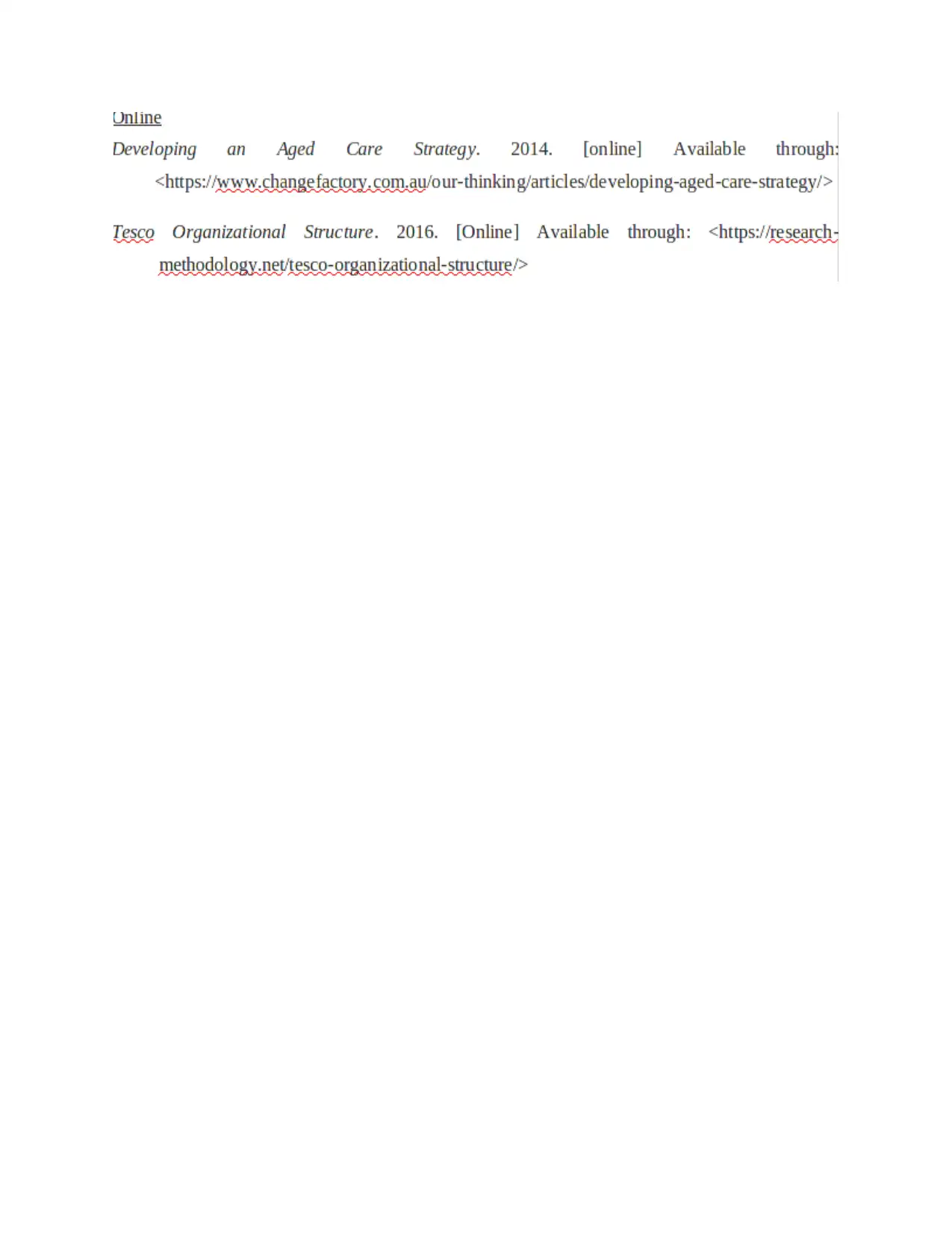
1 out of 19
Related Documents
Your All-in-One AI-Powered Toolkit for Academic Success.
+13062052269
info@desklib.com
Available 24*7 on WhatsApp / Email
![[object Object]](/_next/static/media/star-bottom.7253800d.svg)
Unlock your academic potential
© 2024 | Zucol Services PVT LTD | All rights reserved.





